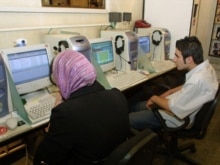"E-readiness" measures the development of electronic communication capabilities on the Internet.
Russia has actually dropped five places since last year, though, and Central Asian states still remain near the bottom of the table in the latest results. Though the "e-readiness" survey is all about the Internet, it looks at much more than just how governments make the Internet accessible to their people, say the survey's authors.
The Central Asian countries' IT and communications infrastructure is not nearly in as good of shape as in other countries in the survey, but mobile penetration is increasing rapidly in these countries.
Many Factors Considered
It's also about the ability of citizens, organizations, companies, and governments to use the Internet efficiently for economic and social benefit. And all these criteria -- modified to take into account new technological developments -- have helped to pinpoint this year's fastest-advancing countries. Denis McCauley is one of the authors of the survey.
"We have reweighted some of our 'e-readiness' criteria this year to have a sharper focus on the legal environment and government policy and vision," he said. "And several of the Asian countries that have advanced strongly, such as Hong Kong and Singapore, as well as Taiwan and Japan and South Korea, I think have stood out."
McCauley says Hong Kong and Singapore are now in the fourth and sixth places of the ranking, respectively, with 8.60 and 8.72 points on a one-to-10 scale after Denmark, the United States, and Sweden. The second group, South Korea, Taiwan, and Japan, are in the 16th to 18th places and moving up quickly.
Also improving fairly rapidly are the countries of Eastern Europe, all positioned between the 28th and 48th places. The leader of them, Estonia, scores 6.84 points while the last in that group, Bulgaria, notches 5.1 points.
Russia And China Rated Low
McCauley says it is disappointing, however, that Eurasian countries are doing much worse. Russia, for example, fell five places since last year to just one place behind China at 57th place, closely followed by Ukraine in 60th place.
McCauley explains, however, that Russia, China, and Ukraine have much in common and also have some positive things going for them.
"What we would call connectivity, or the level of their technology infrastructure nationwide, is not good," he said. "But it is extremely good or much better at least in the major urban centers. In China in the coastal cities and in Russia, of course Moscow, St. Petersburg, and a few other areas. So, there are some bright spots, even though they do, as a whole, rank down in the bottom part of the table."
McCauley explains that on the negative side "censorship is an issue in China and increasingly also in Russia, perhaps in a different context and perspectives," and this keeps both countries low in the rankings.
Despite being low in the table, McCauley stresses that Russia, with 4.27 points, China with 4.43 points, and Ukraine with 4.02 points are developing specialist niches. And they are already able to use technology for economic benefit, particularly in the outsourcing sector and especially in information technology (IT) outsourcing.
Outsourcing Centers
Russia and Ukraine have a large pool of highly skilled software developers with companies that are increasingly able to win business from U.S., European, and Asian firms. China has a large outsourcing business in terms of telecommunications equipment and is increasingly becoming a software-outsourcing center, McCauley said.
As for Central Asia, McCauley says it has not fared as well in "e-readiness" as a region so far, though there are some exceptions.
"There has been progress in Kazakhstan," he added. "You see that its score from last year's 3.22 has increased to 3.78 this year. That's not a bad increase in score; as well as Azerbaijan. Perhaps not [increasing] by as much as some of the others, but part of this has to do with the improvement of their infrastructure."
McCauley says that the Central Asian countries' IT and communications infrastructure is not nearly in as good of shape as in other countries in the survey, but mobile penetration is increasing rapidly in these countries. He said it's becoming a substitute for the lack of fixed-telephone networks and it is having a growing economic impact.
Susanne Dirks is the leader at the Institute for Business Value in Dublin, Ireland, which forms part of IBM's network and has helped the EIU to gather much of the data used for the survey. She stresses that Kazakhstan, Azerbaijan, and Iran -- which is near the bottom of the table, having fallen five places since last year -- can be evaluated in similar terms.
Poor Infrastructure In Central Asia
"If I look at connectivity and technology infrastructure, which is about broadband affordability, broadband penetration, PC ownership, digital signature, and things like that," she said. "I can immediately see that those three countries are very low on the connectivity grip criterion, and they really stand out as being low."
Dirk explains that the social impact of the "e-readiness" level achieved in those three countries is also very low. However, while Iran has fallen in the rankings from 3.15 to 3.08 since last year, Azerbaijan has risen significantly -- going from 2.92 to 3.26 -- and that could mark the beginning of the country's faster economic development.
McCauley concludes that what has made Iran drop in the rankings has not so much to do with a lack of technological progress, but mainly with more general criteria, such as the country's pro-business attitude and whether or not an appropriate legal framework has been created by the government.
"We believe these [issues] are an integral part of 'e-readiness,' even though it's not strictly technology we're talking about," he said. "And Iran has fallen back, for example, in the Economist Intelligence Unit's assessment of its overall business environment."

